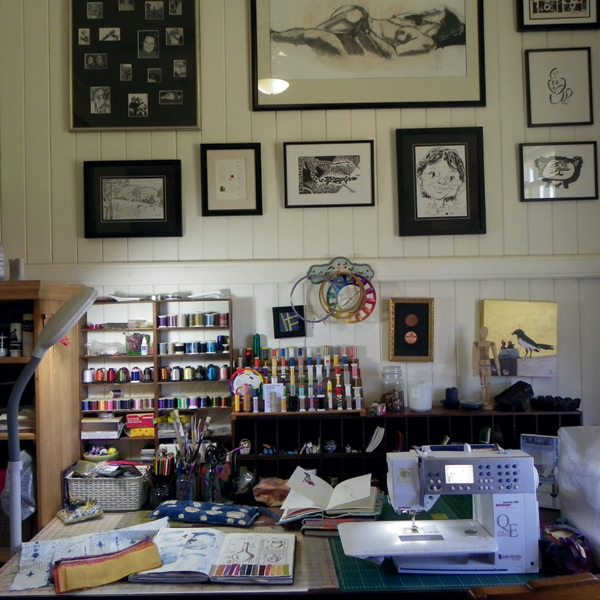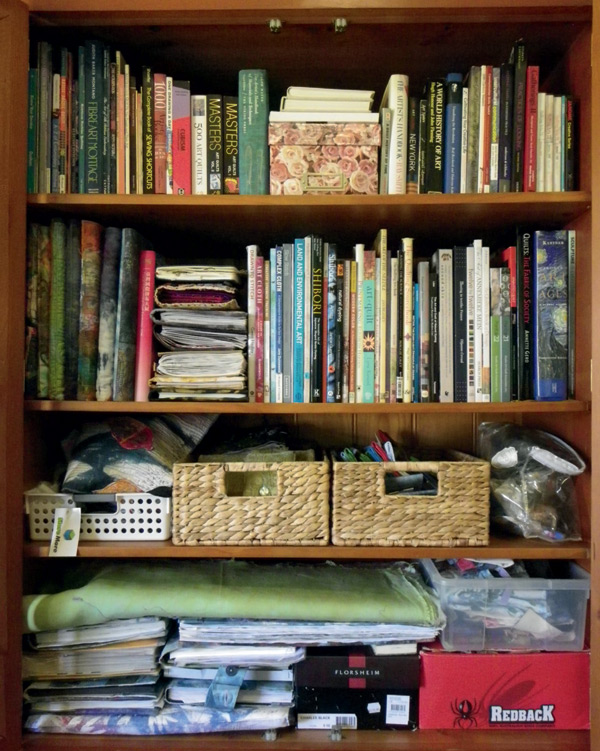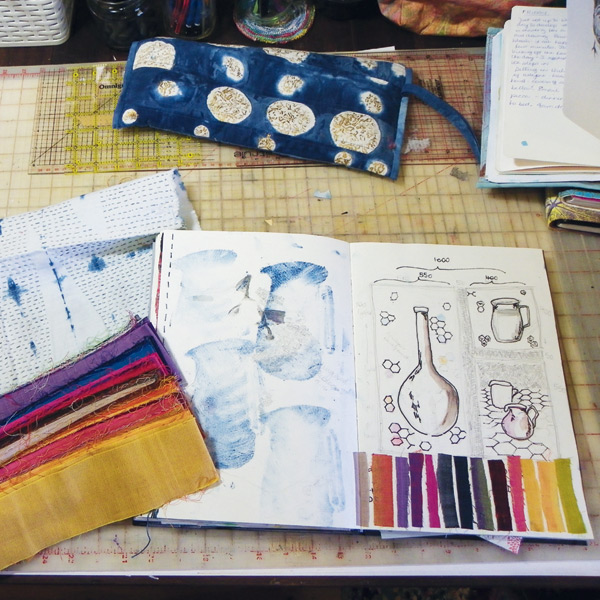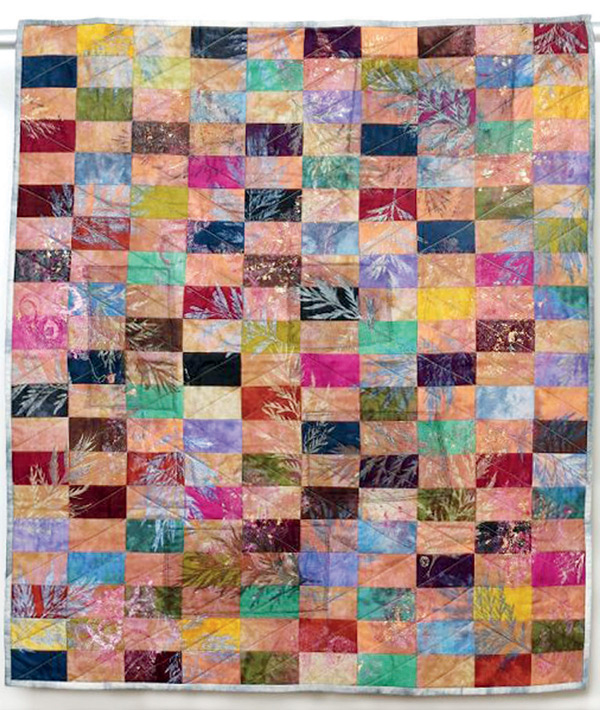
In the Studio with Ali George
Ali George lives in a 90-year-old Queenslander home on a five-acre property in south-east Queensland. We discover how a world-heritage site inspires her
Quilter and textile artist Ali has two studios, one inside her house and another in a converted barn, both with stunning views. The first has “a single, recalcitrant original window facing Cunningham’s Gap and the mountains that form the Main Range National Park between Warwick and Ipswich in south-east Queensland. When the afternoon sun streams through the Gap in autumn, it is a magical and inspirational view of the thousands of acres of vegetable farms that surround us,” says Ali. “The view from the outdoor studio is to the remainder of the mountains that make up the Scenic Rim.”
A purpose-built table runs the full length of her home studio. “I can work on my sewing machine, overlocker or felter as well as have an area for cutting, piecing, hand-stitching and journal work,” she explains. “I also have a separate desk, which houses a laptop computer and a few books and magazines. On the back of the studio door I tape inspirational images — a great big, untidy collage as it were — of places, colours, patterns and designs that I find interesting.”
This room also accommodates a large set of cupboards where Ali stores her art journals, reference books and fabrics. She has only a single shelf of commercial fabric in the cupboard as she sews mostly with her own patterned cloth. There is always plenty of prepared-for-dyeing fabric on hand for dyeing and printing.
Ali’s outdoor studio is a converted barn, adjacent to the house. “Occasionally it converts to a wood-fired oven and entertainment area — but most days of the year it is my printing, dyeing, experimenting and design station,” she explains. “We hold workshops there and it has views to the remainder of the mountains that make up the Scenic Rim. I share the space with a phascogale that resides in a store cupboard (technically phascogales are short-lived so it’s unlikely to be the same one) and the occasional large python. Definitely no vermin hanging around in the outdoor studio!” This studio is spacious and eight people can work there comfortably.
Ali began patchwork and quilting in 1987 and made her first art quilt five years later. “I made traditional quilts until every bed and horizontal surface had a quilt or two, then I started exploring the walls. I’ve always loved to write and draw although I didn’t seriously do either until I was in my 40s. I love textiles and get a thrill just from caressing beautifully woven cotton, or imagining the previous life of a hank of sari silk. My imagination takes flight and that usually triggers some intensive drawing, writing and layering in my art journals — sometimes I have three or four on the go at once.”
Use your patchwork skills to make this Heritage Journal Cover!
In 2011, Ali began studying part time at Curtin University. “I had read Betty Churcher’s Notebooks and I could feel her love and passion for art; I was embarrassed I didn’t already know who she was. I lent the first copy to someone and then had to buy another. I finished the book inspired to learn all I could about art, movement, two dimensions into three, time, space, and how meaning is attached to an object or material and how that could apply to my work with textiles.”
Probably best known for her art quilts, Ali explains her creative process: “I have to write, develop an idea, progress it, change it, research some more and then there is a moment when ‘it’ comes to me and I’m out of the starter’s block. When I have a deadline I tend to spend most of the time thinking about the idea — not so much time is required to create the actual quilt or art piece. I admire those who can experiment straight onto cloth.”
Ali delights in creating uniquely designed fabric. “I particularly love the science of dyeing — either using low-water-immersion processes or nature dyeing with foliage from our rather large gardens,” she says. “My husband, Chris, and I dry different flower heads, collect seeds, harvest lichen from the firewood and experiment on silk and cotton fabrics. We love the serendipity!”
To further explore the patterning process, Ali and her “partner in fabric”, Rebecca Staunton Coffey, formed Ironbark Arts. “We hand-dye and print a range of premium-quality cotton fabrics in fat-quarter and whole-yard pieces. Coming up with our own designs, cutting out stencils or carving lino blocks, discharging, over-dyeing and reinventing each piece is a wonder to me and has never lost its magic. So when I’m on my own or working with Rebecca, we have plenty of room in my outdoor studio for design and print.”
Create a beautiful decorative applique quilt with Irene Blanck’s Minerva Quilt pattern
However, Ali still loves to make traditional quilts and is currently working on a Farmer’s Wife sampler quilt, and makes at least one, but usually two, new blocks each week. “I know that within a year I will have enough blocks for the quilt and that they’ll showcase our Ironbark Arts fabrics in a traditional context,” she says. Then she plans to make an appliqué quilt, designed by Rachelle Denneny.
“I choose projects that take me somewhere new, that extend me and make me work really hard. My two current projects are certainly doing that! I love the fresh air that modern quilting has brought to the table — it’s a big table and there’s room for everyone. I love the idea of exploring positive and negative spaces, which fits with my current studies and provides endless possibilities in my head. My all-time favourite block is the Log Cabin. Whenever I need to tap into something comforting and familiar, it’s the Log Cabin block. I’m also incorporating traditional blocks into my art quilts.” Her two Watershed quilts have Log Cabin blocks as their foundation and her current project, a piece inspired by the artist Margaret Olley, uses hexagonal shapes as a background.
Ali belongs to many textile groups — Quilters’ Guild of South Australia Inc, Queensland Quilters Inc, Ozquilt Network, and Studio Art Quilt Associates (SAQA). She is also one of nine artists in Broad Strokes, who undertake creative challenges together, most recently exhibiting at the Taiwan International Quilt Exhibition with their collection, which then travelled around Australia and New Zealand under the banner of “Our Wishes for the World”.
“It is a thrill to see your work as part of a body of work by so many talented artists; we all interpreted the theme differently yet created a cohesive exhibition that has drawn lots of positive comment in the following months as it tours,” she says. “Prior to that I’ve been blessed to have my quilts exhibited in previous state-of-the-art quilt exhibitions around Queensland as well as part of Mancuso’s World Quilt Exhibitions in the United States. It’s a life-long learning experience and I get so much out of the interaction with other quilters, artists, and people who work in this industry.”
Ali works full-time in Brisbane yet makes time to pass on her skills through workshops such as South Australia’s Quilt Encounter, mini-workshops at a number of major shows around Australia, the Berry Quilt Retreat, as well as weekend workshops and play days at her studio.
Currently, Ali is working on her next exhibition piece for Broad Strokes and also a range of bowls, nests and baskets for 2017 classes. “Having the separate room in the house means that I can lose myself in that space every week when I get home from Brisbane and work,” she explains. “I literally disappear into the pens, pencils, needles, threads, fabrics, books and ‘stuff’ and it feels so good for the soul. I can get that same feeling by ducking into the room in that fragment of time between setting the vegetables to steam and the meal being ready to serve. I can squeeze in a 15-minute practice session of machine quilting or hand-stitch another page of my experiments into an ever-growing book of textiles. When I’m over in the studio shed, I can be there all day and forget to eat or stop for a break until the body protests at all the bending or standing. I particularly love the days when friends arrive and we play, either with the indigo vats, rusting, printing and dyeing.”
Learn zentangle-inspired free-motion machine quilting!
Ali also has other creative goals. “I want to work in series; that is, if you put all my art and traditional quilts together, they would look as if they’ve been made by a hundred different people. I’m working on taking an idea and creating a number of responses to that — it’s something I’ve done a lot in my art journals but not yet created under the needle,” she says. “I would also love to spend more time creating with thread. I love the way free-motion quilting combines with my drawing skills to open a whole world for exploration. But first, I must continue my studies and create a series of works that would lead to a solo exhibition, which I think would be the only thing that’s on my list of ‘getting out there’.”
Ali has refocused her priorities after recent events in her family. “We didn’t have to change much at all — we just got better at spending the 24 hours a day we have doing the things and being with the people that matter,” she explains. “I want to work with people in this business who are about the business of supporting each other, creating fantastic learning environments, sharing skills and being excited by the prospects of meeting new people. Patchwork and quilting matter. Thread matters. The people I meet at shows, workshops and other tutors matter. That’s where I now devote my time and energy.”
Two dedicated studio spaces support these priorities. “The studio is heaven for me, surrounded by farmland with almost no neighbours and serenaded by the hundreds of birds that visit or live on the property. I sometimes find a wren’s nest that has threads from the studio — silk is a particular favourite,” she says. “But if I had a magic wand I would have a permanent wet area included in the outdoor studio. We live on rainwater and having to carry the buckets of water each time I use the studio is a timely reminder of how precious water is as a resource. However, there is a part of me that would simply love to turn on a tap!”







